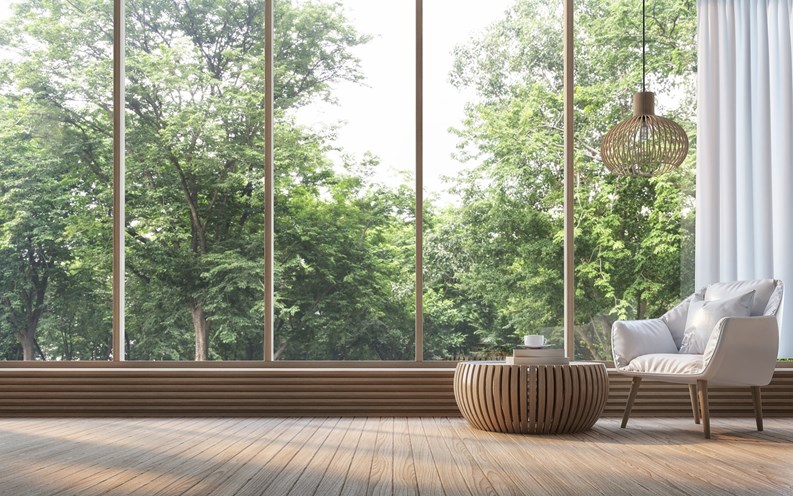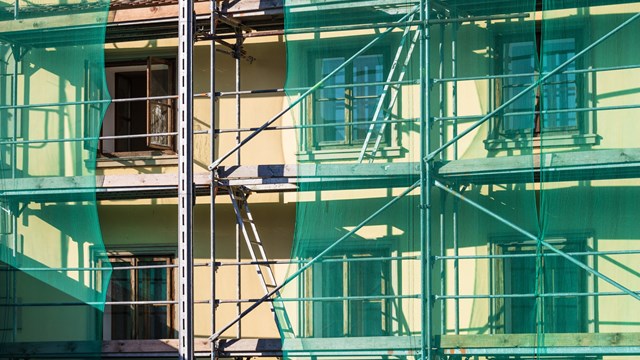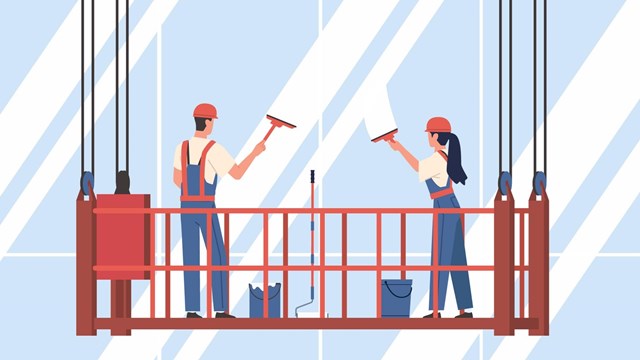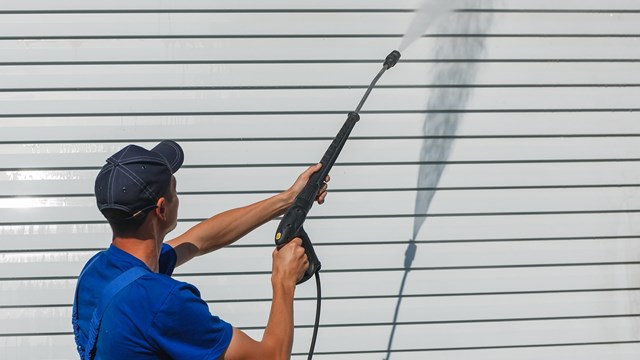Many an apartment-dweller dreams of waking up, pulling back the drapes or raising the blinds, and gazing out their floor-to-ceiling windows toward the horizon, sunlight flooding the space around them. For the lucky few that’s not a fantasy – and those lucky few owe the experience to the development of the glass-and-steel curtain wall.
A Little History
Prior to the development of the curtain wall, the frame, floors, and walls of a building rested on the building’s foundation. The taller the building, the thicker the foundation, and the thicker the exterior walls, generally both built from stone or masonry. The strength of the foundation and the walls supported the interior structure loads.
The introduction of the curtain wall changed everything. It enabled architects and engineers to design and build taller buildings, and permitted more light into the interior of those buildings. The first curtain wall buildings were constructed in the United Kingdom in the mid-19th century.
Curtain wall construction is a hallmark of the Chicago School of architecture and the development of skyscrapers. The first ‘skyscraper’ in Chicago to feature curtain wall construction with a predominantly glass façade was the 10-story Home Insurance building built in 1885 at the corner of LaSalle and Adams Streets. The building came down in 1931, but the use of curtain wall façades continued to develop, primarily with steel frames. By the 1950s the glass front became a symbol of post-war architecture and continues to be so today.
How It Works
The overall concept behind this type of construction is fairly straightforward. The structure of the building is a steel frame built on a concrete foundation. Individual floors are also poured concrete. The curtain wall, usually an aluminum frame which holds the glass, literally ‘hangs’ on the steel frame, secured to it with a system of silicon sealants and gaskets.
Recently-built curtain wall systems generally contain thermo-pane windows. The Thermopane system helps to control both heat and cold loss. This window system combines two quarter-inch plates of glass separated by a half-inch interior space between them. This half-inch air buffer acts as an insulator, to keep heat and cold in or out.
Living With Glass
According to Frank Calandra, president of The Caulking Company, a window and wall service company located in Palos Heights, “Glass has to be cleaned regularly – especially tinted windows. If they get really dirty, it can affect the coating on the inside of the glass. Usually, large buildings get cleaned twice a year. The cleaning is mostly done on scaffolds, as high as we can, no limits. Some buildings have tie-downs on the walls so you can snug the cables into the building; that way, if there is a strong wind you’re not blowing around.”
Jon Boyd and Glenn Johnson are CEO and senior associate II, respectively, of Klein & Hoffman, an architectural and structural engineering firm with offices in Chicago and Philadelphia. Their firm provides services for glass and aluminum construction in Illinois, Pennsylvania and New Jersey. They work closely with builders and building owners of all types of glass façade properties. “The primary maintenance for glass is washing; soap and water,” says Boyd. “The metal part is more complicated.” “It depends on the metal and its finish,” says Johnson.
Despite notions that glass is a fragile, delicate material, the durability and longevity of glass and metal curtain wall systems is actually excellent. “Some buildings are nearing 50 and 60 years old,” says Johnson. “Their longevity is clearly 50 years or longer with minimal maintenance, washing and minimal resealing.” Boyd adds that, “Modern systems are long-lived.” He explains that “Historically, the departure point is where the industry went from non-insulated glass to insulated glass,” which occurred in the mid-1970s. “Some earlier systems had less effective insulated glass seals. Today, with higher-quality seals, there is little problem with fogging. The facades can remain in good working condition for decades.”
Atmospheric Conditions
Different environments can lead to different needs and problems for glass façade curtain wall construction. Cold and wind in Chicago or New Jersey have different effects than heat and hurricanes in Florida. And then there are earthquakes. Glass and aluminum curtain walls must account for stressors that include wind, snow, heat, cold, seismic activity...even man-made blasts. Sy Dorn, founder and director of Clearview Building Services in Davie, Florida, says that in his state, as well as others on the Gulf Coast, “The windows are hurricane windows. The panes are pressed together,” for more strength. Hurricane windows are a necessity in storm-prone regions, as recently demonstrated by the path of destruction cut through the state by Hurricane Irma, and many before her.
“In a big storm,” says Calandra, “you can get leaks. There is negative atmospheric pressure,” from the storm, as well as more water than the system may be designed to handle. Calandra explains that moisture is the main concern with glass façades. Curtain wall systems are composed of two parts: vision glass and spandrel glass. Vision glass is the glass through which we look outside or in. It’s almost always Thermopane and according to Calandra, “takes care of itself.” Spandrel glass is darker, and spans the beams between floors. There is insulation behind it to keep moisture out. “Regardless,” he says, “all glass and aluminum systems will take on water at some point.”
“In a northern climate, the tendency is for humid, indoor air to move toward the exterior during the cold months,” says Johnson, “and if that moisture reaches an area of dew point or a pane of glass, it can condense. The vapor can freeze within the element and create problems. In a southern climate, you have the opposite effect, where the moist air tries to migrate to the air-conditioned interior of the building in summer months. That creates a similar problem, which can contribute to mold growth.”
Despite that, glass and metal systems are generally low maintenance. Johnson explains that “Glass costs more than masonry, but masonry actually requires more maintenance over the decades. Glass and aluminum can be maintenance-free for 30, 40 years or more. It really comes down to the quality of the system at installation.” As concerns overall cost of construction, glass-and-steel buildings also “tend to rent and sell for more, and more quickly. The ability to build all-glass buildings is going away though. You have to have more opaque areas, brick or shaded glass, to meet today’s energy requirements in many places. All glass loses and gains too much heat.”
That loss of energy is a result of natural physical law; hot flows to cold. In a cold climate like Chicago’s, the interior warm air will radiate to the much colder air outside. In a hot climate like Florida, the heat load from the searing sunshine will make cooling interiors much more difficult, especially in a glass-walled apartment. That difficulty in cooling can translate to dollars and cents for owners. But for many of these people, “If there is loss, these people can afford it,” says Dorn, “and they don’t think about it.”
Living in a Fish Bowl
Besides the building-wide concerns associated with glass and aluminum curtain walls and the societal concerns over their energy efficiency, there are personal considerations for those of us living in these dramatic settings. The abundant sunlight can have a less-than-desirable effect on what we put in the ‘fishbowl’ – specifically furniture, drapes and artwork.
Along with abundant sunshine, untreated glass lets in UV rays which can have a detrimental effect on fabrics, paints and other valuable items. The remedy for much of this damage is special coatings, specifically ‘low-E’ or low-emission coatings which reduce radiant infra-red energy. They are more effective overall than films applied to the interior windows, “Which produce a mirror effect,” says Johnson, “that makes it difficult to see the skyline at night” – the exact opposite of what most residents in glass buildings wanted when they bought their units in the first place. “If there’s no UV protection,” says Dorn, “all furniture will fade. You need UV protection in Florida. Today in new buildings, the glass installed is usually treated and UV protected.” Coated or not, the pros advise hanging your Picasso on a wall not in the path of direct sunlight.
In addition to his professional career in glass maintenance and cleaning, Frank Calandra is also himself the owner of a ‘fishbowl’ apartment. “I love it,” he says, and says he would buy one again. Currently, he has his large, wide-screen TV mounted on and between the supporting columns in front of his floor-to-ceiling windows in his ‘unit in the sky’ in downtown Chicago. When he watches the Cubs, he can look out over the city that cheers them on.
A J Sidransky is a staff writer/reporter for The Chicagoland Cooperator, and the author of several published novels.










Leave a Comment